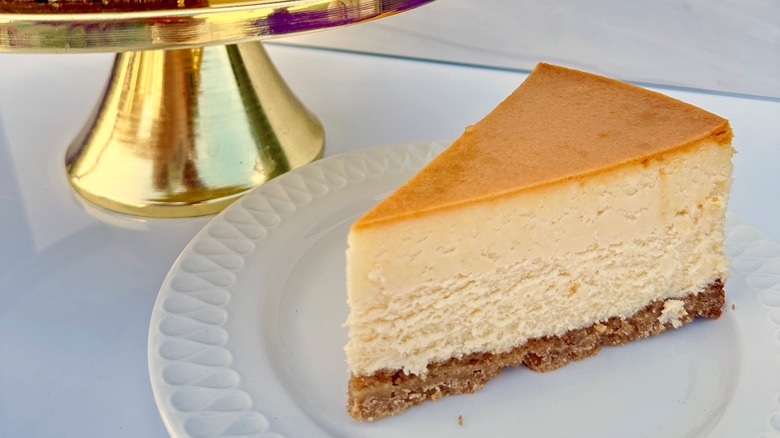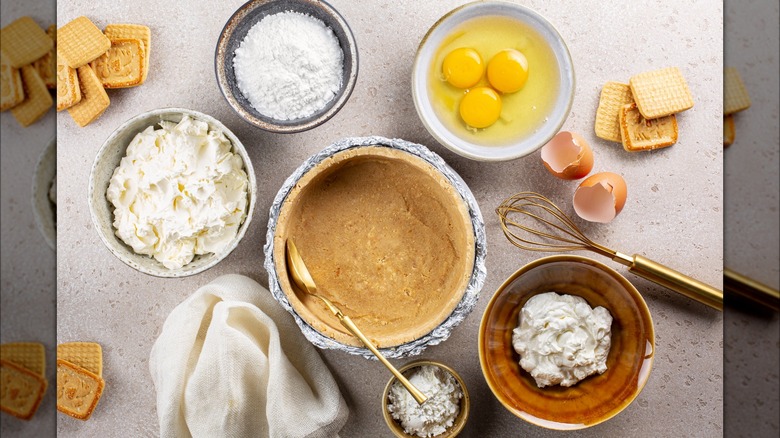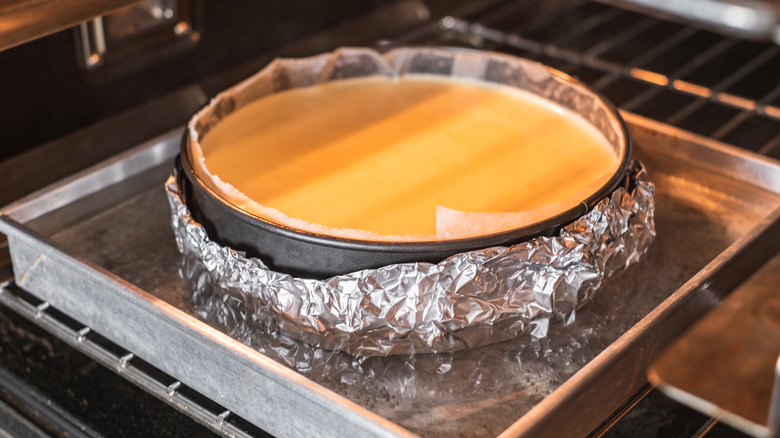The 3 Most Important Tips For Making The Perfect Cheesecake, According To An Expert
When we're in the mood for a decadent dessert, our first thought is a slice of cheesecake. It doesn't matter if it's the classic New York style, topped with fruit, or some outrageous flavored version you can only find at The Cheesecake Factory. If it's made with a full-fat cream cheese, sugar, and has a buttery graham cracker crust, we're all in! While buying cheesecake from a little shop is an easy way to satisfy one's craving, there's nothing quite as gratifying as making it yourself.
Unlike other cakes that are made from flour, sugar, and eggs, and then poured into a pan and baked until done, a cheesecake takes a little more finesse. If you don't take a little extra time and add an extra step or two, the final result could be a disaster that will end up in the trash.
Since no one wants to throw away all their hard work, we asked Julia Tokarz and Gregory Lay, the brilliant minds behind East Side Cheesecakes in Los Angeles, what they recommend to ensure that our cheesecake will come out as luscious and decadent as theirs. At the recent Los Angeles Wine & Food Festival the chefs told us there are three rules they always adhere to no matter which of their 10 cheesecakes they're baking.
Ingredients should be room temperature before baking
One of the things that makes cheesecake the luxurious dessert it is, is its silky smooth texture. That creaminess isn't just from the cream cheese and sour cream, but from the fact that all the ingredients are brought to room temperature before they're blended together. Even though it will definitely add to your total cooking time, Tokarz said no matter what, don't skip this step. In fact, one of the biggest tips she recommends is "making sure that your ingredients are room temperature before you begin."
Cheesecakes are made up of several refrigerated ingredients, and while the fridge may extend the life of your eggs, cream cheese, and sour cream, you never want to pull them out and immediately start mixing. The cold temperature turns those ingredients into hard blocks, which means it will take longer for them to break down and blend together. Instead, pull everything out at least an hour before you start so they have a chance to soften up. Taking this extra, all-important step ensures that everything will mix more easily. But softening the cream cheese and sour cream also means you're less likely to have lumps throughout your cake, and we can't think of anything worse than a lumpy cheesecake.
Bake in a water bath
Named after Mary the Jewess, the first known alchemist who came up with the concept, the hot water bath, or bain-marie, has been around for centuries and is often used for crème brûlées and flans. But Tokarz told us it's also absolutely necessary when making cheesecake. The hot water bath may seem like an extra hassle, but it "is really, really important to help keep the temperature consistent and it helps prevent the cracking," explained the chef. That cracking usually occurs because the heat from the oven causes the surface of the cake to dry out too quickly. The bain-marie provides the extra moisture needed to keep the surface of the cake moist for the whole baking process, thus alleviating any stress on the cake's surface area and keeping it intact.
While this cooking method may have stopped you from making a cheesecake or flan in the past, it doesn't take that much extra effort. All you need is a large pan and some boiling water. Once your cheesecake is ready to bake, simply place your cheesecake in the larger pan and place the whole thing into a preheated oven. Then, fill the larger pan with boiling water about halfway up the cake pan and bake. It's that easy.
Don't open the oven door while cooking
Whenever we get excited about whatever dessert we're baking, all we want to do is crack open the oven door and take a peek, just to make sure everything looks okay. But Tokarz warned us not to. Opening the oven door not only lets cool air in, adding extra minutes to your baking time, but it could ruin the final dessert by putting extra stress on it while trying to maintain an even temperature to compensate for that blast of cold air.
"You know a lot of people say, 'Open the oven, don't open the oven. Let it cool outside, don't let it cool outside,'" explained Tokarz. "I don't believe in cracking the oven for me, personally." The chef said she just takes her cheesecakes out once the timer goes off. "Cooking it low and slow, you don't need to crack the oven," she reiterated. "You don't need to go through that. Just let it finish and then take it out and enjoy." Considering how amazing her cheesecakes are, we'll definitely heed her advice. Now, we just need to make sure our oven light is working, you know, in case we still want to take a peek through the glass.



